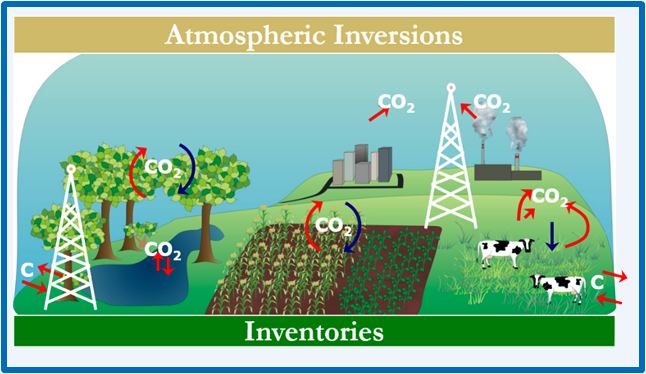
PRESS RELEASE- Verifying Biogenic Greenhouse Gas Emission Inventories with Atmospheric Carbon Dioxide Concentration Data

PRESS RELEASE
Verifying Biogenic Greenhouse Gas Emission Inventories with Atmospheric CO2 Concentration Data
National governments throughout the world report greenhouse gas emissions to the United Nations Framework Convention on Climate Change (UNFCCC). The reported values need to be verified to ensure that they accurately represent a country’s contribution to greenhouse gas concentrations in the atmosphere, but the verification is a challenge for biogenic emissions that often go unmeasured. In a paper published in Environmental Research Letters, Stephen Ogle at the Natural Resource Ecology Laboratory of Colorado State University, along with investigators from Pennsylvania State University, DOE Pacific Northwest National Lab, US Forest Service, NOAA, Arizona State University, and Michigan Tech Research Institute have evaluated an approach for verifying biogenic emissions reported to the UNFCCC using atmospheric CO2 concentration data.
Biogenic pools, such as carbon in trees, crops and soils, can be a significant net source or sink for CO2 to the atmosphere. The source or sink strength of these pools depends on the land use and management in a country, which is influenced by a variety of activities such as deforestation, timber production and forest management, wildfires, and agricultural commodity production. Verifying the CO2 fluxes associated with biogenic carbon pools is challenging because the pools are widespread and difficult to monitor, and are impacted by complex interactions associated with management activities, weather patterns and local site characteristics. However, the atmosphere integrates the effect of all fluxes, providing a means for evaluating the influence of these widespread activities across a region.
“Verifying the CO2 fluxes associated with biogenic carbon pools is challenging because the pools are widespread and difficult to monitor, and are impacted by complex interactions…However, the atmosphere integrates the effect of all fluxes, providing a means for evaluating the influence of these widespread activities across a region.”
The investigators faced several challenges to verify biogenic emissions data that governments reported to the UN. The challenges included filling gaps in biogenic carbon budget for a region, and combining data of different types, such as remote sensing products, commodity statistics and land surveys. Investigators also overcame challenges associated with deploying tower-based instruments in the region to monitor the atmospheric CO2 concentrations.
Focusing on the Midwestern region of the United States, the investigators found that this area’s biogenic carbon pools were a net sink for atmospheric CO2, but much of the carbon is only stored temporarily in crops that are harvested in this region, transported to other areas of the United States and emitted in subsequent years.
Investigators determined that changes in atmospheric CO2 concentration over time were mostly consistent with the biogenic emissions reported for the Midwestern United States. The only inconsistencies occurred near the border between Minnesota and Wisconsin, suggesting that the reported biogenic flux for this area requires further investigation. This approach will be extremely valuable for identifying and correcting errors in the biogenic emissions reported to the UN.
Atmospheric CO2 concentration data are available through the NOAA Global Monitoring Division in-situ observation network and the recent launch of the NASA Orbiting Carbon Observatory-2 satellite. With an increase in sampling locations similar to the network deployed in this study, the resulting data combined with the approach discussed in this article will provide a strong basis to verify biogenic emissions that are reported to the UNFCCC in coming years.
Publication:
Ogle, S.M., K. Davis, T. Lauvaux, A. Schuh, D. Cooley, T.O. West, L.S. Heath, N.L. Miles, S. Richardson, F.J. Breidt, J.E. Smith, J.L. McCarty, K. Gurney, P. Tans, and A.S. Denning. 2015. An Approach for Verifying Biogenic Greenhouse Gas Emissions Inventories with Atmospheric CO2 Concentration Data. Environmental Research Letters, in press.